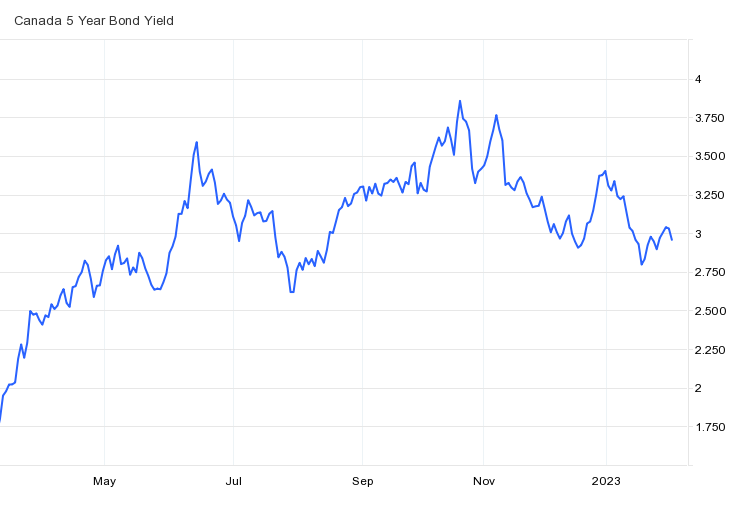Rising interest rates have put a strain on the Canadian housing market over the past year, and if you’ve got monthly mortgage payments to make there’s no doubt you’ve been feeling the pressure. However, a silver lining does exist when it comes to rising interest rates: if it costs more to borrow money, that also means you can make more from lending your money.
In our monthly mortgage market outlook we often talk about the bond market in Canada, which behaves similarly to the mortgage market, closely following changes to the Bank of Canada’s policy interest rate, and giving us clues into where banks and lenders think rates are headed.
With rising interest rates, two important investment assets become more lucrative: bonds and GICs. Let’s talk about each asset and why you might want to include it in your investment portfolio, whether you’re saving up for a down payment or planning for retirement.
What is a bond?
A bond is an investment vehicle you can buy into in exchange for a return on your cash. Think of a bond like a loan that you give to a company or the government. In exchange for lending your money for a set period of time, the bond issuer promises to pay you back the money plus interest.
Not all bonds are the same however, and the bond market can be a complicated topic. First of all there are different types of bonds, from corporate debt, to government bonds. It’s common nowadays to simply buy shares of an ETF (Exchange Traded Fund) that tracks the bond market, offering you interest on the bonds the fund holds in the form of dividends. For example, you might hold the Vanguard Aggregate Bond Index ETF (VAB) in your RRSP as a part of your retirement strategy, to generate income. You can also buy bonds directly in your investment account, for example the Bank of Canada’s Real Return Bonds which require a minimum investment of $5,000.
Like other assets, bonds can be bought and sold for a price. A common source of misunderstanding arises when something like a bond fund fluctuates in price over time. The reason for this is because interest rates rise and fall, which affects the rate companies and the government are willing to pay to borrow money. If you buy a $100 bond one year when interest rates are 5%, and the next year they rise to 6%, someone wouldn’t be willing to pay the same amount that you paid for that bond because they could buy a bond from today with a higher rate of interest. To mitigate this risk, investment firms will purchase bonds over time, creating what’s called a bond ladder. In addition, not all bonds are fixed rate, meaning some bonds’ interest rates change along with the prime rate.

What is a GIC?
A Guaranteed Investment Certificate, or GIC for short, is similar to a bond in that it is a type of investment, in which you lend your money in exchange for an agreed upon interest rate. When you buy a GIC, you’re lending money to a bank or other financial institution for a set period of time, just like a bond.
Unlike some bonds, GICs have a fixed interest rate that’s guaranteed for the entire term of the investment. This means that you know exactly how much money you’ll earn from your investment before you even buy the GIC. For example, let’s say you buy a GIC from a bank for $1,000 and it has an interest rate of 5% for a term of 1 year. At the end of the year, you’ll get back your $1,000 plus an extra $50 in interest guaranteed.
Most commonly you will buy a GIC in an investment account with a bank or other financial institution. GIC’s are sold for a fixed term, for example 6 months, 1 year, or 5 years. The rate of interest offered on a GIC is influenced by the length of the term, and the Bank of Canada’s policy interest rate.
Unlike some bonds which can be bought and sold, with a GIC your money is locked in and it’s highly unlikely you would be able to get your money back early without a large penalty fee.
GICs can be a great investment option for those looking for a risk-free fixed income source, and are confident in their long-term planning. GICs in Canada are insured by the CDIC and are considered one of the safest investment assets someone can buy. If you’re sure you won’t be needing cash for a period of time (let’s say a year), and you aren’t going to invest it, there’s nearly no reason to keep it in a savings account over purchasing a GIC.
What is the difference between a Bond and GIC?
Bonds and GICs are very similar investments, they are both loans to a financial entity in exchange for interest and your principal returned. They are also both considered conservative income generating assets for investors with low risk tolerance or looking to diversify their portfolio with lower risk assets.
Bonds cover a much wider range of assets, for example corporate bonds or foreign government bonds, and also can have different terms. Some bonds are fixed rate, and some are variable. If you buy into a bond fund, the value of the fund will appreciate and depreciate over time with how investors are evaluating the bond market.
GIC’s offer a much more limited, and therefore potentially safer and easier to understand, investment vehicle. GICs may offer a higher rate of guaranteed return, in exchange for less liquidity compared with a bond. On the other hand, some bonds may appreciate in value if interest rates lower, and are also more liquid, allowing an investor to cash in on their investment more easily. The value of a bond can fluctuate depending on changes in interest rates and the creditworthiness of the issuer, which means you may not get back the full value of your investment if you need to sell before the maturity date.
Overall, GICs and bonds serve different purposes in a portfolio. GICs are a good option for people who want a safe and predictable investment with a guaranteed return, while bonds are a good option for people who want the potential of a higher return and the flexibility to buy and sell their investments. Ultimately it’s up to you and your financial advisor to determine which is the right choice for your portfolio.
To see where interest rates are predicted to go over the next 5 years check out our latest interest rate outlook by our head of mortgage advisory.
 Ali
Ali






